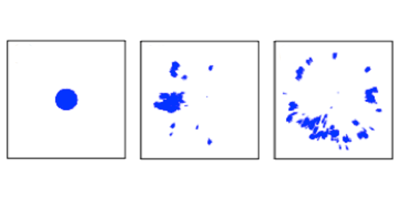Bird Flocks Shatter on Impact
Flocking birds are well known for their magnificent swarming behavior, where thousands of individuals move as one entity. These flocks have clear boundaries, which seemingly hold the birds in. Researchers typically model such collective systems by representing each bird as a self-propelled particle, with neighboring particles coupling by aligning their velocities. The dynamics of the flocks can then be simplified and analyzed in terms of traditional “flowing” material properties. This has led Nicholas Ouellette and Pearson Miller at Yale University to question what would happen if the flock flew into a wall. From its fluidlike behavior, you might expect it to splash like a raindrop. Writing in Physical Review E, Ouellette and Miller show instead that impacting flocks shatter like brittle solids.
In their simulations, the team started with a well-defined flock and drove it towards a solid wall. Initially, the impacting flock flattened into a pancake, compressing against the wall. Individuals at the front rebounded off the wall, disrupting the oncoming flock. This process continued until most of the particles were moving away from the wall and the original flock had broken into distinct smaller clusters. By studying the size distribution of the clusters, Ouellette and Miller were then able to infer the material properties of the flock on impact—splashing liquids break up into droplets of similar size, while brittle solids split into pieces of all sizes. The authors saw the latter, suggesting that the flock behaved as a brittle solid, rather than a splashing droplet. – Katherine Wright





